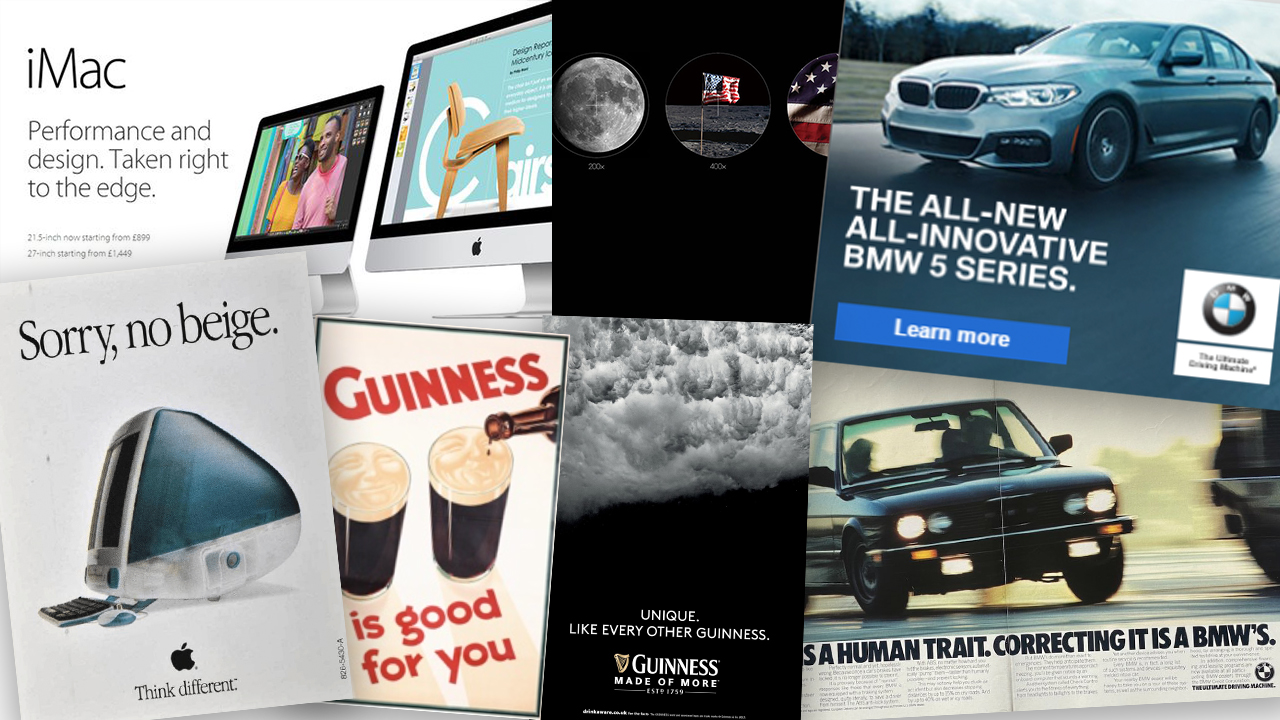
Marketers worldwide are asking themselves the question – Has advertising lost its edge? Has cancel culture taken over?
When we think about the most exciting and inspiring pieces of advertising, we think fondly of those adverts from yesteryear such as Apple’s 1984 Super Bowl commercial or Surfer by Guinness.
Those adverts often have very little to do with the product they’re trying to promote and encompass some key marketing fundamentals associated with brand building and product fit. Advertisers have had to change their ways over the years to accommodate new laws and regulations, as well as the rise of digital media. Has it become too safe though?
A big shout-out to John Long for sharing a thread on Twitter about this topic. Thanks for inspiring this article.
The Fundamentals of great advertising
Going back to basics
If you ask 100 people, ‘What’s the purpose of advertising?’ You’re likely to get 100 different answers.
There are however some very basic concepts all adverts should follow.
- Does it represent the brand in the right light?
- Are we communicating the unique selling point(s)?
- Are we presenting the key features and benefits?
An advert needs to be able to answer one or more of these questions, and it should be applicable to 90 percent of the audience. Marketers should refrain from writing paragraphs of copy to answer those questions.
This ad from Orion Telescopes is a key example of answering those questions succinctly. Look at the ads and ask yourself those three questions.
Does it represent the brand in the right light? ✅ Are we communicating the unique selling point(s)? ✅ Are we presenting the key features and benefits? ✅

Don’t forget about the marketing mix
Looking back at adverts from long ago, we often think of them with nostalgia and fondness. There is warmth and sophistication about them.
Many of them, like this advert for Marlboro cigarettes, were incredibly successful. Marlboro and other cigarette brands would often be in the hands of cowboys and movie heroes and were fully integrated into popular culture.
However, society and the industry have had to move away from such adverts.

Advertisers mustn’t forget the role of advertising within the marketing mix. Advertising (Promotion) is just one part of the wider mix.
Price – Product – Promotion – Place – People – Process – Physical Evidence
The promotional mix has changed dramatically since the 80s and 90s with digital marketing forming a huge part of the promotional mix. Your brand and messaging must work hard to succeed in the digital environment.
Has advertising become safer because marketers are focusing more of their effort on the whole marketing mix?
Apple’s shift from customer orientation to product orientation
These Apple advertisements are a great example of shifts from a customer-orientated approach to a product-orientated approach.
In the 90s iMac advertising used phrases like: “Sorry, not beige” and “Chic. Not Geek”. Not overtly risky, but poking fun at what was on offer within the PC market.
They focused on brand and USPs. They knew the average customer wouldn’t be able to tell the difference between kilobytes, megabytes and shark bites. So they kept the message simple.
If you want a PC that looks good – Think different, think Apple.

If we take a look at Apple’s new iMac advert, it’s undoubtedly more product orientated. There could be two reasons for this.
- Apple is much more of a household name than it was in the 90s and its consumer base is more tech-savvy. With that, the advertising has seemingly matured in line with its audience.
- Or has their advertising become too safe?

ASA Rules
The Advertising Standards Authority (ASA), which is the UK’s independent advertising regulator, has over time cracked down on certain types of advertising. The ASA are there to protect consumers and businesses and take action to ban misleading, harmful, offensive or irresponsible ads.
Ads promoting motoring, alcohol and or directed at children all have their own classification of codes to adhere to.
How has this affected the way we advertise?
BMW
Looking at the examples below from BMW, we can see how the CAP code will have influenced the advertising message. The first advert shows an image of a car moving with great speed and agility. It covers about 80 percent of a double-page spread.
It’s very clear the car is built for performance. But what does the ASA say about this?
Section 19 of the CAP code states:
Marketing communications should not condone or encourage unsafe or inconsiderate driving practices.


Section 19 further states: ‘Marketing communications must not depict speed in a way that might encourage motorists to drive irresponsibly or to break the law.’ and ‘Marketers must not make speed or acceleration the main message of their marketing communications.’
It’s quite clear that the first advert would not be compliant as speed is certainly the main message of the advert. The second advert focuses on innovation and is more likely to be compliant.
Guinness
Guinness is another great example of advertising gone safe. In this case, the rules are very clear, stating:
Marketing communications must not imply that alcohol can enhance mental or physical capabilities
Whilst you may struggle to find too many people on a Sunday morning to disagree with that notion, Guinness famously claimed that ‘Guinness is good for you’.


One might suggest that a safer approach by Guinness has spawned a raft of award-winning and inspiring adverts.
This Know Your Limits campaign video is a great example of how an ad can be quite shocking and adhere to the ASAs rules.
Does ‘unsafe’ advertising still exist?
YES! It absolutely does still exist, and some of it is brilliant and on the edge.
John’s Twitter thread does provide a list of ads that have become safer over time, but brands are still pushing the advertising envelope.
Bodyform’s ad promoting the brand’s new Goodnight towels resulted in 798 complaints to the ASA. Some describe the sight of menstrual blood within the ad as “too graphic” and “unnecessary”, to being “degrading and demeaning to women”.
Bodyform certainly risked upsetting a large proportion of the population on a matter that many still consider to be a private affair.
Elvie, similarly, went all out with its LEAKS HAPPEN campaign. The ad’s purpose was to spotlight and champion women’s health, particularly the taboos around urinary incontinence.
Seeing a woman urinating on a billboard is clearly going to ruffle a few feathers. Ultimately its purpose is to get consumers talking about the core subject.
Elvie would call this campaign a success with the campaign video receiving over a million views and a 109 percent uplift in Google searches for the brand during the campaign launch week.
There is a line between risking offence to a small minority and causing mass offence. Marketing Beat has put together a list of the Top six most outrageous ads banned this year.
It does feel like advertising has had to become safer over recent years. Ultimately it’s in the public interest to ensure that certain types of products and services are more closely monitored and scrutinised than others.
Let me know in the comments if you think advertising has become too safe.




